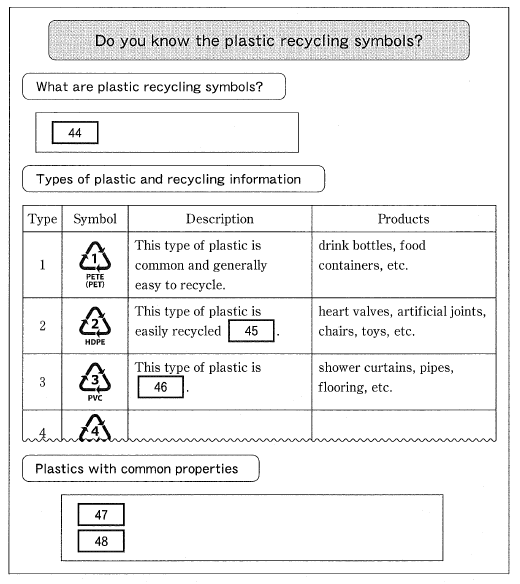問題
You are in a student group preparing a poster for a scientific presentation contest with the theme “What we should know in order to protect the environment.” You have been using the following passage to create the poster.
Recycling Plastic
─What You Need to Know─
The world is full of various types of plastic. Look around, and you will see dozens of plastic items. Look closer and you will notice a recycling symbol on them. In Japan, you might have seen the first symbol in Figure 1 below, but the United States and Europe have a more detailed classification. These recycling symbols look like a triangle of chasing pointers, or sometimes a simple triangle with a number from one to seven inside. This system was started in 1988 by the Society of the Plastics Industry in the US, but since 2008 it has been administered by an international standards organization, ASTM (American Society for Testing and Materials) International. Recycling symbols provide important data about the chemical composition of plastic used and its recyclability. However, a plastic recycling symbol on an object does not always mean that the item can be recycled. It only shows what type of plastic it is made from and that it might be recyclable.

So, what do these numbers mean? One group (numbers 2, 4, and 5) is considered to be safe for the human body, while the other group (numbers 1, 3, 6, and 7) could be problematic in certain circumstances. Let us look at the safer group first.
High-density Polyethylene is a recycle-type 2 plastic and is commonly called HDPE. It is non-toxic and can be used in the human body for heart valves and artificial joints. It is strong and can be used at temperatures as low as -40℃ and as high as 100℃. HDPE can be reused without any harm and is also suitable for beer-bottle cases, milk jugs, chairs, and toys. Type 2 products can be recycled several times. Type 4 products are made from Low-density Polyethylene (LDPE). They are safe to use and are flexible. LDPE is used for squeezable bottles, and bread wrapping. Currently, very little Type 4 plastic is recycled. Polypropylene (PP), a Type 5 material, is the second-most widely produced plastic in the world. It is light, non-stretching, and has a high resistance to impact, heat, and freezing. It is suitable for furniture, food containers, and polymer banknotes such as the Australian dollar. Only 3% of Type 5 is recycled.
Now let us look at the second group, Type 1, 3, 6, and 7. These are more challenging because of the chemicals they contain or the difficulty in recycling them. Recycle-type 1 plastic is commonly known as PETE (Polyethylene Terephthalate), and is used mainly in food and beverage containers. PETE containers ─ or PET as it is often written in Japan ─ should only be used once as they are difficult to clean thoroughly. Also, they should not be heated above 70℃ as this can cause some containers to soften and change shape. Uncontaminated PETE is easy to recycle and can be made into new containers, clothes, or carpets, but if PETE is contaminated with Polyvinyl Chloride (PVC), it can make it unrecyclable. PVC, Type 3, is thought to be one of the least recyclable plastics known. It should only be disposed of by professionals and never set fire to at home or in the garden. Type 3 plastic is found in shower curtains, pipes, and flooring. Type 6, Polystyrene (PS) or Styrofoam as it is often called, is hard to recycle and catches fire easily. However, it is cheap to produce and lightweight. It is used for disposable drinking cups, instant noodle containers, and other food packaging. Type 7 plastics (acrylics, nylons, and polycarbonates) are difficult to recycle. Type 7 plastics are often used in the manufacture of vehicle parts such as seats, dashboards, and bumpers.
Currently, only about 20% of plastic is recycled, and approximately 55% ends up in a landfill. Therefore, knowledge about different types of plastic could help reduce waste and contribute to an increased awareness of the environment.
Your presentation poster draft:

問1 Under the first poster heading, your group wants to introduce the plastic recycling symbols as explained in the passage. Which of the following is the most appropriate? ( 44 )
- They are symbols that rank the recyclability of plastics and other related problems.
- They provide information on the chemical make-up and recycling options of the plastic.
- They tell the user which standards organization gave them certificates for general use.
- They were introduced by ASTM and developed by the Society of the Plastics Industry.
問2 You have been asked to write descriptions of Type 2 and Type3 plastics. Choose the best options for ( 45 ) and ( 46 ).
Type ( 45 )
1. and commonly known as a single-use plastic
2. and used at a wide range of temperatures
3. but harmful to humans
4. but unsuitable for drink containers
Type 3 ( 46 )
1. difficult to recycle and should not be burned in the yard
2. flammable; however, it is soft and cheap to produce
3. known to be a non-toxic product
4. well known for being easily recyclable
問3 You are making statements about some plastics which share common properties. According to the article, which two of the following are appropriate? (The order does not matter.) ( 47 )・( 48 )
- Boiling water (100℃) can be served in Type 1 and Type 6 plastic containers.
- It is easy to recycle products with Type 1, 2, and 3 logos.
- Products with the symbols 1, 2, 4, 5, and 6 are suitable for food or drink containers.
- Products with Type 5 and Type 6 markings are light in weight.
- Type 4 and 5 plastics are heat resistant and are widely recycled.
- Type 6 and 7 plastics are easy to recycle and environmentally friendly.
【解説】問1
Under the first poster heading, your group wants to introduce the plastic recycling symbols as explained in the passage. Which of the following is the most appropriate?
最初のポスターの見出しの下で、あなたのグループは、一節で説明されているように、プラスチックリサイクルの記号を紹介したいと考えています。次のうちどれが最も適切ですか?

この記号が何を意味しているのかを、選択肢から選ぶ問題ですね。選択肢を確認してみましょう。
1. They are symbols that rank the recyclability of plastics and other related problems.
これらは、プラスチックリサイクルの可能性や、その他の関連する問題をランク付けする記号です。
記号の中にある数字が、ランキングの数字なんでしょうか。記号の中にある数字について、第二段落にこうあります。
So, what do these numbers mean? One group (numbers 2, 4, and 5) is considered to be safe for the human body, while the other group (numbers 1, 3, 6, and 7) could be problematic in certain circumstances.
では、これらの数字はどういう意味ですか?一方のグループ(番号2、4、および5)は人体にとって安全であると見なされますが、もう一方のグループ(番号1、3、6、および7)は特定の状況で問題になる可能性があります。
リサイクルの記号にある数字は、ランキングではありませんでしたね。この選択肢は違います。
2. They provide information on the chemical make-up and recycling options of the plastic.
それらは、プラスチックの化学的構成と、リサイクルオプションに関する情報を提供します。
「 プラスチックの化学的構成 」については、第一段落にこうあります。
Recycling symbols provide important data about the chemical composition of plastic used and its recyclability.
リサイクルの記号は、使用されるプラスチックの化学組成と、そのリサイクル可能性に関する重要なデータを提供します。
選択肢と同じ内容です。この選択肢が正解です。
3. They tell the user which standards organization gave them certificates for general use.
それらは、どの標準化団体が一般的な使用のために、証明書を与えたかをユーザーに伝えます。
「証明書」の話はありませんでした。この選択肢は違います。
4. They were introduced by ASTM and developed by the Society of the Plastics Industry.
それらは ASTM によって導入され、Society of the Plastics Industry によって開発されました。
ASTM に関しては、第一段落にこうあります。
This system was started in 1988 by the Society of the Plastics Industry in the US, but since 2008 it has been administered by an international standards organization, ASTM (American Society for Testing and Materials) International.
このシステムは、1988年に米国プラスチック工業協会によって開始されましたが、2008年以降、国際標準化機構であるASTM(American Society for Testing and Materials)Internationalによって管理されています。
ASTM はリサイクル記号を導入したのではなく、管理しています。この選択肢は違います。
ということで正解は「2」です。

「the chemical make-up」と「the chemical composition」のように、選択肢の「2」の内容は、本文と言葉が言い換えられています。そこに気づければわかりますね。
【解説】問2
You have been asked to write descriptions of Type 2 and Type3 plastics. Choose the best options for ( 45 ) and ( 46 ).
タイプ2とタイプ3のプラスチックの説明を書くように頼まれました。( 45 )と( 46 )に最適な選択肢を選択してください。
Your presentation poster draft: の( 45 )と( 46 )に何が入るかという問題です。( 45 )はタイプ2の説明、( 46 )はタイプ3の説明になっています。実質二つの問題ですね。
まずは ( 45 ) の空所がある部分を確認しましょう。
This type of plastic is easily recycled ( 45 ).
このタイプのプラスチックは簡単にリサイクルでき、( 45 )。
この部分はタイプ2の説明の欄です。タイプ2に関しては、本文の第三段落に書いてあります。選択肢の内容と照らし合わせながら、確認していきましょう。
1. and commonly known as a single-use plastic
そして一般的に使い捨てプラスチックとして知られています
本文の第三段落にこうあります。
Type 2 products can be recycled several times.
タイプ2の製品は複数回リサイクルできます。
タイプ2はリサイクルできます。使い捨てではありません。この選択肢は違います。
2. and used at a wide range of temperatures
そして広範囲の温度で使用されます
温度に関しては、第三段落にこうあります。
It is strong and can be used at temperatures as low as -40℃ and as high as 100℃.
それは丈夫で、最低-40℃から最高100℃の温度で使用できます。
-40℃~100℃は広範囲ですよね。この選択肢が正解です。
3. but harmful to humans
しかし人間に有害
人間に有害かどうかについては、第二段落にこうあります。
One group (numbers 2, 4, and5) is considered to be safe for the human body,
一方のグループ(番号2、4、および5)は人体にとって安全であると見なされます
タイプ2は人体にとって安全です。この選択肢は違います。
4. but unsuitable for drink containers
しかし、飲み物の容器には不向き
飲み物の容器に関しては、第二段落にこうあります。
HDPE can be reused without any harm and is also suitable for beer-bottle cases, milk jugs, chairs, and toys.
HDPEは害を及ぼすことなく再利用でき、ビール瓶のケース、ミルク差し、椅子、おもちゃにも適しています。
milk jugs が飲み物の容器に該当します。Type 2 は飲み物の容器に不向きではありません。この選択肢は違います。
ということで、( 45 ) は「2」です。
次は、( 46 )の空欄がある部分を確認しましょう。
This type of plastic is ( 46 ).
このプラスチックのタイプは( 46 )です。
この部分はタイプ3の説明の欄です。タイプ3に関しては、本文の第四段落に書いてあります。選択肢の内容と照らし合わせながら、確認していきましょう。
1. difficult to recycle and should not be burned in the yard
リサイクルが難しく、庭で燃やしてはいけません
タイプ3のリサイクルに関しては、第四段落にこうあります。
PVC, Type 3, is thought to be one of the least recyclable plastics known. It should only be disposed of by professionals and never set fire to at home or in the garden.
タイプ3のPVCは、最もリサイクル性の低いプラスチックとして知られているものの1つと考えられています。それは専門家によってのみ処分されるべきであり、家や庭に火をつけてはいけません。
庭で燃やしてはいけないと書いてありますね。この選択肢が正解です。
2. flammable; however, it is soft and cheap to produce
可燃性; しかし、それは柔らかくて安価に生産できます
タイプ3の部分にそのような記述はありませんでした。よく燃えて、安いという特徴は「タイプ6」です。この選択肢は違います。
3. known to be a non-toxic product
無毒な製品であることが知られています
non-toxic に関しては、第三段落にこうあります。
It is non-toxic and can be used in the human body for heart valves and artificial joints.
それは無毒であり、心臓弁および人工関節のために人体で使用することができます。
ただこれはタイプ2の話であって、タイプ3の内容ではありません。この選択肢も違います。
4. well known for being easily recyclable
リサイクルが容易なことでよく知られています
選択肢「1」の時に確認したとおり、タイプ3はリサイクルが難しいです。この選択肢は違います。ということで( 46 )は「1」です。

本文の ( 45 ) に該当する部分と、( 46 ) に該当する部分が離れています。同じ問2だからといって続けてしようとすると、てんやわんやになります。本文を読み進めて、タイプ2のところに来たら ( 45 ) に取り組む。タイプ3のところに来たら ( 46 ) に取り組むというように、分けてやるといいですね。
【解説】問3
You are making statements about some plastics which share common properties. According to the article, which two of the following are appropriate? (The order does not matter.) ( 47 )・( 48 )
あなたは、共通の特性を共有するいくつかのプラスチックについて発言しています。記事によると、次のうち適切なものはどれですか? (順番は関係ありません)
プラスチックが7つに分類されていましたが、共通する特性があるんですね。どれとどれがどういう特性で共通しているかを、選択肢を確認しながら見ていきましょう。
1. Boiling water (100℃) can be served in Type 1 and Type 6 plastic containers.
沸騰したお湯(100℃)は、タイプ1とタイプ6のプラスチック容器で提供できます。
タイプ1の温度に関しては第四段落にこうあります。
Also, they should not be heated above 70℃ as this can cause some containers to soften and change shape.
また、70℃以上に加熱しないでください。一部の容器が柔らかくなり、形が変わる可能性があります。
タイプ1は100℃では使えません。この時点でこの選択肢は違うとわかります。ですが、一応タイプ6についても確認してみましょう。
タイプ6に関しては第四段落にこうあります。
It is used for disposable drinking cups, instant noodle containers, and other food packaging.
使い捨てのコップ、即席めん容器、その他の食品包装に使用されます。
即席めんの容器に使われるのですから、100℃のお湯は大丈夫ですね。ですがタイプ1が当てはまらない時点で、この選択肢は違います。
2. It is easy to recycle products with Type 1, 2, and 3 logos.
タイプ1、2、3のロゴが付いた製品は簡単にリサイクルできます。
タイプ1のリサイクルに関しては、第四段落にこうあります。
Uncontaminated PETE is easy to recycle and can be made into new containers, clothes, or carpets
汚染されていないPETEはリサイクルが容易で、新しい容器、衣服、またはカーペットにすることができます
そのあとに「汚染されているとリサイクルできない可能性がある」とありますが、タイプ1自体はリサイクルが容易とありますので〇にしておきましょう。
タイプ2のリサイクルに関しては、第三段落にこうあります。
Type 2 products can be recycled several times.
タイプ2の製品は数回リサイクルできます。
「簡単」に関する言葉はありませんが、数回リサイクルできるということは、タイプ2も〇でいいのではないでしょうか。
タイプ3のリサイクルに関しては、第四段落にこうあります。
PVC, Type 3, is thought to be one of the least recyclable plastics known.
タイプ3のPVCは、最もリサイクル性の低いプラスチックとして知られている1つと考えられています。
タイプ3はリサイクルしにくいですね。タイプ3がダメということで、この選択肢は違います。
3. Products with the symbols 1, 2, 4, 5, and 6 are suitable for food or drink containers.
記号1、2、4、5、および6の製品は、食品または飲料の容器に適しています。
タイプ1は第四段落にこうあります。
Recycle-type 1 plastic is commonly known as PETE (Polyethylene Terephthalate), and is used mainly in food and beverage containers.
リサイクルタイプ1のプラスチックは通称PETE(ポリエチレンテレフタレート)として知られており、主に食品や飲料の容器に使用されています。
食品と飲料の容器に使われています。タイプ1は〇です。
タイプ2に関しては第三段落にこうあります。
HDPE can be reused without any harm and is also suitable for beer-bottle cases, milk jugs, chairs, and toys.
HDPEは害を及ぼすことなく再利用でき、ビール瓶のケース、ミルク差し、椅子、おもちゃにも適しています。
ミルク差しが飲料の容器に当たります。タイプ2は〇です。
タイプ4に関しては第三段落にこうあります。
LDPE is used for squeezable bottles, and bread wrapping.
LDPEは、絞り出し可能なボトルやパンの包装に使用されます。
食品の容器に使っていますね。タイプ4は〇です。
タイプ5は第三段落にこうあります。
It is suitable for furniture, food containers, and polymer banknotes such as the Australian dollar.
家具、食品容器、オーストラリアドルなどのポリマー紙幣に適しています。
食品容器に使っています。タイプ5は〇です。
タイプ6に関しては第四段落にこうあります。
It is used for disposable drinking cups, instant noodle containers, and other food packaging.
使い捨てのコップ、即席めん容器、その他の食品包装に使用されます。
即席めんの容器は食品の容器に当たります。タイプ6も〇です。選択肢に書かれてあるすべてのタイプが〇なので、この選択肢が正解です。
4. Products with Type 5 and Type 6 markings are light in weight.
タイプ5およびタイプ6のマーキングが付いた製品は軽量です。
タイプ5の重さに関しては、第三段落にこうあります。
It is light, non-stretching, and has a high resistance to impact, heat, and freezing.
軽くて伸縮性がなく、耐衝撃性、耐熱性、耐凍性に優れています。
軽いですね。タイプ5は〇です。
タイプ6の重さに関しては、第四段落にこうあります。
However, it is cheap to produce and lightweight.
しかし、製造が安価で軽量です。
軽いです。タイプ6も〇です。選択肢に書かれてあるすべてのタイプが〇なので、この選択肢が正解です。
5. Type 4 and 5 plastics are heat resistant and are widely recycled.
タイプ4および5のプラスチックは耐熱性があり、広くリサイクルされています。
タイプ4のリサイクルに関しては、第三段落にこうあります。
Currently, very little Type 4 plastic is recycled.
現在、タイプ4のプラスチックはほとんどリサイクルされていません。
ほとんどリサイクルされていません。タイプ4はダメです。
タイプ5のリサイクルに関しては、第三段落にこうあります。
Only 3% of Type 5 is recycled.
タイプ5は3%しかリサイクルされていません。
ほとんどリサイクルされていませんね。タイプ5もダメです。ということでこの選択肢は違います。
6. Type 6 and 7 plastics are easy to recycle and environmentally friendly.
タイプ6および7のプラスチックは、リサイクルが容易で環境に優しいものです。
タイプ6のリサイクルに関しては、第四段落にこうあります。
Type 6, Polystyrene (PS) or Styrofoam as it is often called, is hard to recycle and catches fire easily.
タイプ6、ポリスチエン(PS)または発泡スチロールとよく呼ばれますが、リサイクルが難しく、発火しやすいです。
リサイクルは難しいです。タイプ6はダメです。
タイプ7のリサイクルに関しては、第四段落にこうあります。
Type 7 plastics (acrylics, nylons, and polycarbonates) are difficult to recycle.
タイプ7のプラスチック(アクリル、ナイロン、ポリカーボネート)はリサイクルが困難です。
リサイクルは難しいです。タイプ7はダメです。この選択肢は違います。
ということで正解は「3」と「4」です。

選択肢順に内容を確認していこうとすると、本文あちこち探し回らないといけなくなります。本文を読みながらプラスチックのタイプごとに区切って、その都度選択肢に〇や×の印をつけていく手順でやるのがよいでしょう。




コメントをどうぞ